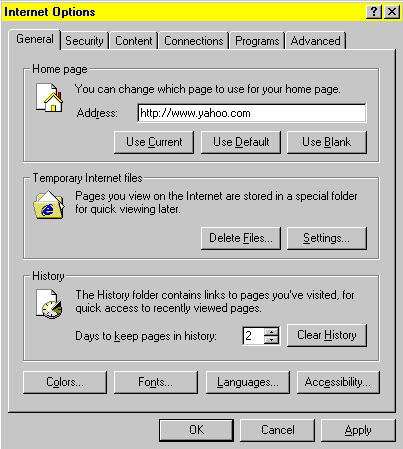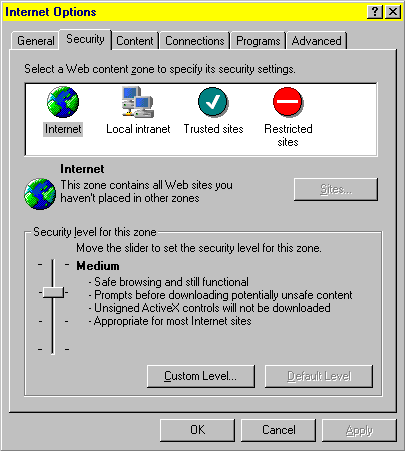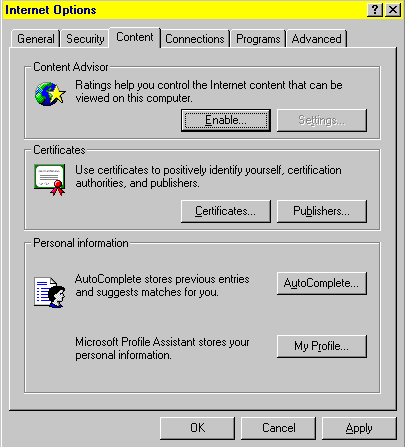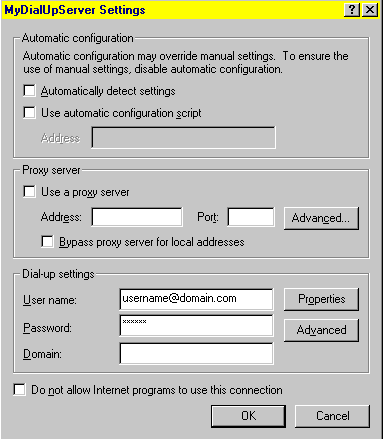|
|

|
|
|
Quick Links: | General Tab & Cache Clearing | Security Tab & Cookies | Content Tab & MS Content Advisor | Connections Tab | Proxy Configuration | Other Tabs | These screen shots cover the configuration of IE5. They include specific directions for setting up proxy settings, clearing caches & histories, and the various other issues involved with configuring a browser. Please note that the screen shots for IE4 are quite different in the Connection tab. You definitely want to upgrade to IE5 (or higher) if you have enough hard disk and RAM available. You can configure Internet Explorer through either of two routes: Open IE -> Tools Menu -> Internet Options or Control Panel -> Internet Options. Please note that IE4 and earlier versions of IE will have a plain "Internet" folder rather than an "Internet Options" folder. The first route is pictured below: <next>
General Tab: Setting Home Pages and Clearing Cache & History The first "General" tab is where you set your home page. This will be the first page that your browser goes to when you open IE5. Microsoft defaults it to MSN's home page in an effort to sell unwanted Internet services. You will need to reset and apply that home page address. You can also set a "blank" home page if desired. Click "delete files" and "clear history" when setting up proxy filtering. Otherwise, any smutty content that is already downloaded to the computer will remain accessible. <next>
Security Tab: Cookies Since downloads, Javascript and cookies can be harmful, the Security Tab determines how they are handled. Select one of the four zones to modify your security policy. The Internet zone is of interest to us for a dialup modem connection. The Medium setting is recommended for this zone. If you set it higher then you probably won't be able to fully utilize most websites including our own.
Some web sites store information in a small text file on your computer. This file is called a cookie. If you prefer to use the High security setting, websites that require cookies won't be viewable. Customizable web pages where you can do things like setup a weather report for certain cities generally rely on this technology. If you can view most websites but run into problems with others, you may have your privacy settings too high. Restricting all cookies will make it impossible to logon to our main home page. Other websites may not be viewable at all or customization features such as news/weather/stock may not work. You can either change back to the Medium setting or click the Custom Level button to enable cookies (shown below).
Content Tab (Microsoft Content Advisor) Do NOT enable the MS Content Advisor. It is highly buggy and unreliable. It is also very difficult to disable because you either have to do a risky "registry hack" or totally reinstall the operating system and all applications. If the Content Advisor button says "enable" as pictured below then the Content Advisor is not activated. If that button says something like "edit" or "configure" then we have a problem. <next> Registry Hack For Disabling MS Content Advisor
Connections Tab & Proxy Configuration The connections tab is where you specify which dial-up (DUN) connection to use with Internet Explorer. That window will show all DUN connections that currently exist in the dial-up networking folder in My Computer. You can add or remove DUN settings from here. In fact, you should remove any DUN configurations that exist from prior internet connections which are no longer being used. Most people need to be set to "always dial my default connection." You don't want to do this at work if you connect through a LAN rather than a modem. [You won't want IE5 demanding to connect through your modem every time that you open a new IE5 window while working on a workplace network.] The "dial whenever a network connection is not present" option often tries to use a modem connection even though you are already connected to a LAN. However, this is a very convenient option if you only use a modem to connect to the internet. Once you are through, click the "settings" button to configure the proxy settings and automate IE5 to connect to the internet when its icon is clicked on your desktop. <next>
The screen below is where you setup the proxy settings and automate IE5 to logon automatically with the correct username and password. Once you've configured the proxy address, be sure to clear the cache and history in the General Tab! Otherwise, preloaded smut will still be in your computer. Our proxy can keep that stuff out but anything already loaded in the cache will remain viewable until cleared. The proxy address is available from your ISP. The dial-up settings boxes are where you configure Internet Explorer to connect automatically with a username and password. Your login is username@ispname.com (or .net). Be sure to include the domain tail on the end so that it looks like an e-mail address even though it isn't necessarily an e-mail address. This will help your connection to find out ISP in the public phone system. Don't add any other checkmarks. The screen below is just the way the your settings should look except that you will need to apply your actual ISP domain and username. The advanced button is where you can setup the connection to automatically disconnect "when connection may no longer needed" or after a specified time period. The properties button is covered further below. <next>
The properties button is a link to the DUN settings in My Computer. An example of that screen is shown below. You can change those settings from here. Please see the General Training -> DUN Clients -> Windows 9X section of this website for further details. <click here for those details> <next>
Other Tabs: Programs & Advanced Don't worry about the Programs and Advanced tabs. They shouldn't effect our internet and e-mail connections except that the programs tab will let you determine which e-mail program is linked to Internet Explorer. <return to top> <windows browsers page> <windows home page>
|







